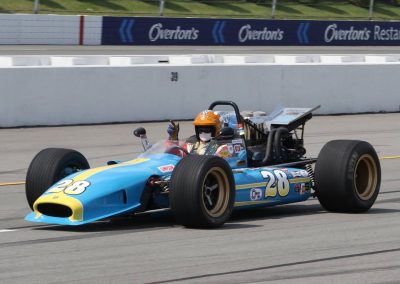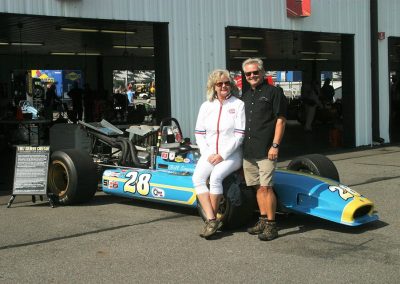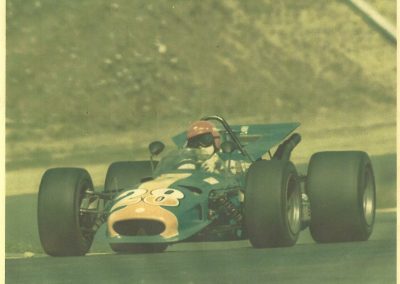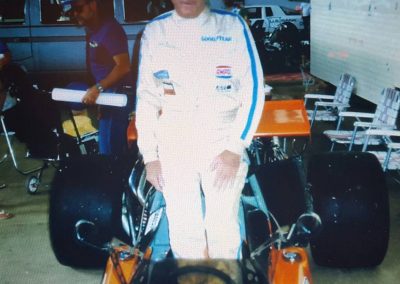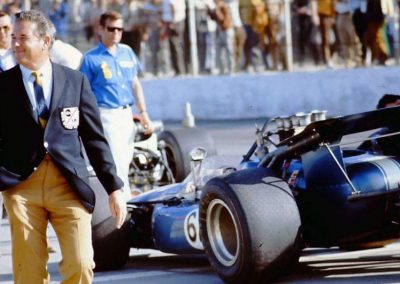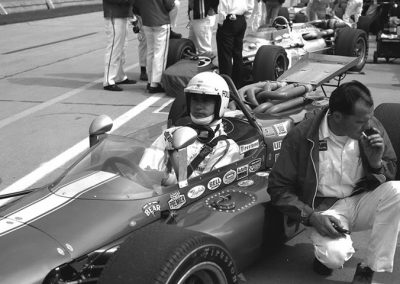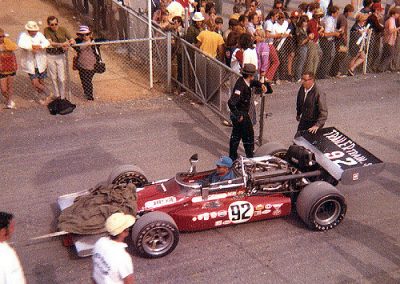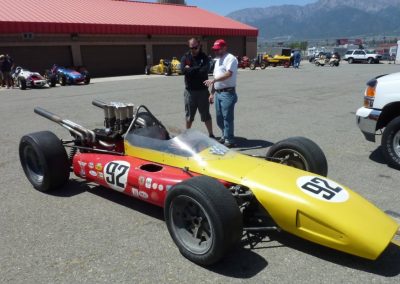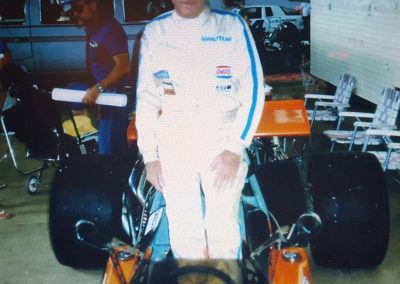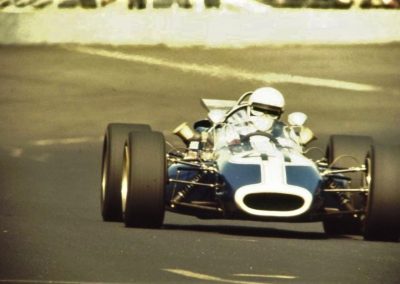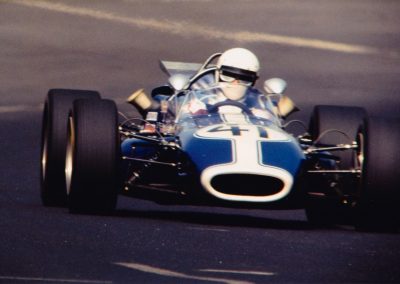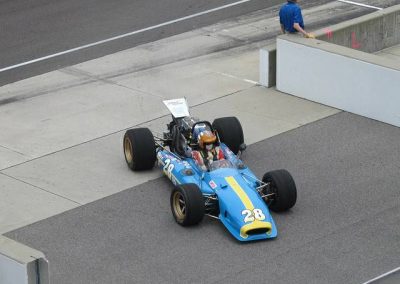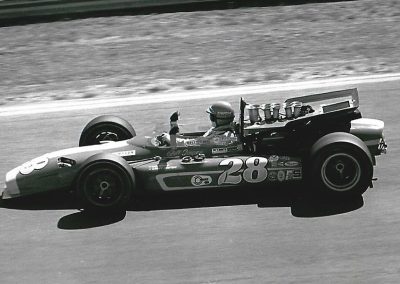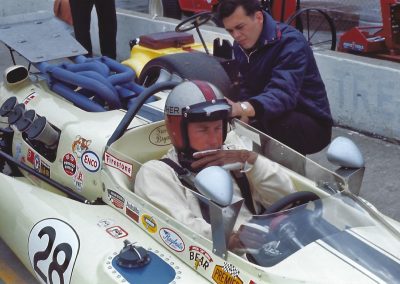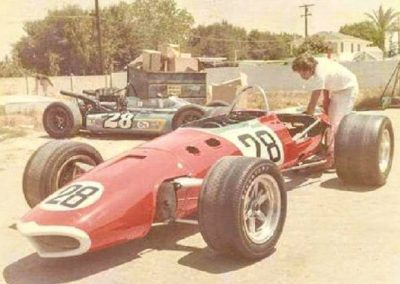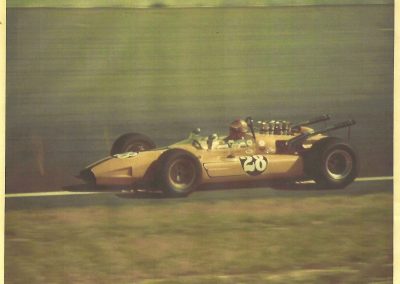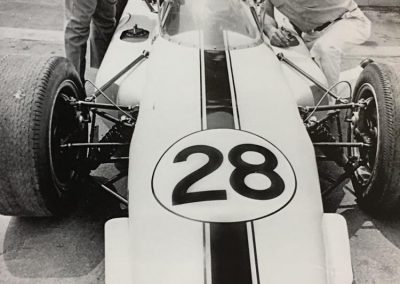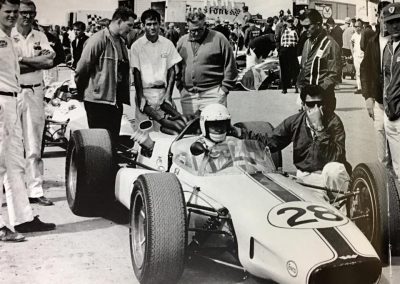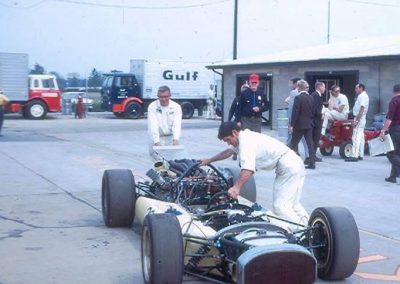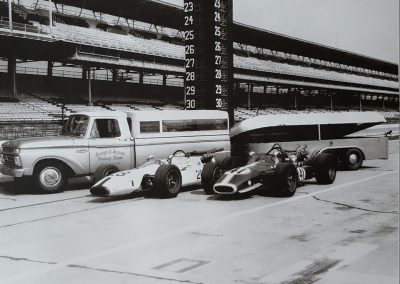
“We Need to Build Our Own Car”
The Story of the Gilbert Cheetah
[The following story was first published by the Classic Racing Times in the Fall of 2017.]
George R. Bryant was a somewhat typical Indy Car owner of the 1960s, a successful businessman who, having made his fortune, turned to his passion for racing. Bryant’s wealth came from his brokerage mailing list company based in Englewood, New Jersey, and his hometown of Tenafly, New Jersey was less than three miles from the Teaneck Armory wherein 1962 a young Mario Andretti won what he later described as his “first victory of any consequence” in indoor TQ Midget racing.
 Bryant campaigned Ford-powered BRP cars for the 1965-67 USAC championship seasons with Masten Gregory as one of his drivers. Gregory was George Bryant’s stepson, but nepotism had little to do with Gregory being in the seat. Masten Gregory had a solid racing resume, albeit one that might lend itself more to today’s Indycar climate than to the 1960s. Gregory had enjoyed considerable success in domestic and European sports car racing and was a top runner in Formula One prior to joining his stepfather at Indianapolis in 1965.
Bryant campaigned Ford-powered BRP cars for the 1965-67 USAC championship seasons with Masten Gregory as one of his drivers. Gregory was George Bryant’s stepson, but nepotism had little to do with Gregory being in the seat. Masten Gregory had a solid racing resume, albeit one that might lend itself more to today’s Indycar climate than to the 1960s. Gregory had enjoyed considerable success in domestic and European sports car racing and was a top runner in Formula One prior to joining his stepfather at Indianapolis in 1965.
According to Gregory biographer Michael Cox, Gregory’s mother did not like Masten racing to begin with and was particularly opposed to the idea of her husband providing the ride. But at the 1965 Indy 500 Gregory qualified Bryant’s BRM on the last row (thirty-first) and in the race he passed a remarkable fourteen cars on the opening lap and was up to fifth before engine problems ended his day and left him 23rd overall.
 Ongoing results at Indianapolis were not what Bryant had hoped for. In 1966, with Johnny Boyd driving, Bryant’s BRM Ford was involved in a lap 5 crash. In 1967 Bryant entered two cars, one of which, driven by Chris Amon, failed to qualify, and the second of which, with Carl Williams at the controls, was taken out by a late-race crash. So at the 1967 Indy 500 victory banquet Bryant turned to his master mechanic, Howard Gilbert, and asked, “what will it take to win this thing?” Gilbert’s response was straightforward: “We need to build our own car.”
Ongoing results at Indianapolis were not what Bryant had hoped for. In 1966, with Johnny Boyd driving, Bryant’s BRM Ford was involved in a lap 5 crash. In 1967 Bryant entered two cars, one of which, driven by Chris Amon, failed to qualify, and the second of which, with Carl Williams at the controls, was taken out by a late-race crash. So at the 1967 Indy 500 victory banquet Bryant turned to his master mechanic, Howard Gilbert, and asked, “what will it take to win this thing?” Gilbert’s response was straightforward: “We need to build our own car.”
As it happened, Gilbert was a friend of Ron Tauranac, engineer for Jack Brabham, and later that same evening Tauranac agreed to give Gilbert a set of Brabham blueprints. Gilbert, backed by Bryant, then set out to build a fresh race car with the Brabham plans and a few tricks of his own. Quin Epperly was brought in to fabricate the aluminum components and George Salih was an available resource as well. Salih was the creator of the laydown Offy roadster concept, a design which won the Indy 500 in 1957 and 1958, and Gilbert had worked with him at that time.
 Gilbert’s new race car was finished late in 1967 and powered by a 255-cid four-cam Ford V8. It was intended to be Masten Gregory’s ride for the 1968 Indy 500.
Gilbert’s new race car was finished late in 1967 and powered by a 255-cid four-cam Ford V8. It was intended to be Masten Gregory’s ride for the 1968 Indy 500.
Gilbert needed a name for the new car and “Cheetah” was chosen. Why Cheetah? Gurney had the Eagle, Brawner the Hawk and Foyt the Coyote so Gilbert named his car after an animal that had speed unmatched by any other land animal. Car number 28 was assigned to Gilbert Cheetah chassis 1.
The first tests for chassis 1 took place at Phoenix International Raceway in January of 1968, with Gregory, Joe Leonard, and Art Pollard each doing some driving. When the January test sessions were over George Follmer raced chassis 1 in the first three races of the USAC championship season in March and April of 1968 because Gregory had commitments to race a Ferrari 250LM at Daytona and a McLaren M1C at USRRC events. At the season opener at Hanford, California, Follmer qualified the 17th out of 28 entries and finished the race in 11th spot. At Stardust Raceway in Las Vegas Follmer improved his qualifying position to sixth but retired from the race due to suspension problems, scoring a 15th-place finish. At Phoenix Follmer qualified 22nd out of 31 entrants but suffered a crash on the first lap, finishing last.
 Reportedly, during the PIR testing in January of 1968, Joe Leonard liked chassis 1 so much that he asked Gilbert to build a second car for him to drive at Indy in 1968. So, at some point in early ‘68, construction of a second chassis was begun and that car was finished in time for Indy. But by then Leonard had gotten a ride in one of Andy Granatelli’s second-generation turbines, which he put on the pole for the 500. As a result, George Follmer was slated to drive chassis 2, which had been given the number 41 and another 255-cid four-cam Ford V8. Gregory was still to drive Cheetah chassis 1, which retained the number 28.
Reportedly, during the PIR testing in January of 1968, Joe Leonard liked chassis 1 so much that he asked Gilbert to build a second car for him to drive at Indy in 1968. So, at some point in early ‘68, construction of a second chassis was begun and that car was finished in time for Indy. But by then Leonard had gotten a ride in one of Andy Granatelli’s second-generation turbines, which he put on the pole for the 500. As a result, George Follmer was slated to drive chassis 2, which had been given the number 41 and another 255-cid four-cam Ford V8. Gregory was still to drive Cheetah chassis 1, which retained the number 28.
But the USAC tech inspectors at Indianapolis told Howard Gilbert that the roll bar on chassis 2 was too low for Follmer, so Follmer used chassis 1 for his rookie test while Gilbert welded an additional smaller hoop on top of the original roll bar of chassis 2. Follmer then qualified chassis 2 but got bumped out of the starting field by a faster car.
 Gregory, once on the track in chassis 1, was slower than expected in practice. It has been said that Gregory was preoccupied with the crash and death of his good friend Jim Clark at the Hockenheimring in Germany just one month earlier and that this distraction caused Gregory to be slow at Indy. So team owner Bryant put Rick Muther in chassis 1 for practice, and he was fast, so Bryant let Muther attempt to qualify. On the second lap of his qualification run, Muther put chassis 1 in the wall, and it could not be repaired in time for another attempt. Ultimately, Gregory never made a qualification attempt and neither he nor Muther nor Follmer made the 1968 race.
Gregory, once on the track in chassis 1, was slower than expected in practice. It has been said that Gregory was preoccupied with the crash and death of his good friend Jim Clark at the Hockenheimring in Germany just one month earlier and that this distraction caused Gregory to be slow at Indy. So team owner Bryant put Rick Muther in chassis 1 for practice, and he was fast, so Bryant let Muther attempt to qualify. On the second lap of his qualification run, Muther put chassis 1 in the wall, and it could not be repaired in time for another attempt. Ultimately, Gregory never made a qualification attempt and neither he nor Muther nor Follmer made the 1968 race.
After Indy, on June 13th team owner George Bryant went into the hospital for heart surgery, but he died on the table. Just two days later, on June 15th, Follmer drove chassis 2 at Mosport where, after encountering fuel system issues, he completed 35 of the scheduled 40 laps as was credited with an 11th-place finish. But Bryant’s widow asked Howard Gilbert to take charge of selling off the team, and before the end of the year chassis 1 was sold to Bill Simpson and chassis 2 was sold to Follmer. Gilbert acquired the team’s trucks and trailers.
 At the season-ending Rex Mays 300 at Riverside in early December, Simpson drove chassis 1 to a 28th-place finish, completing only five laps before an oil seal failure put him out. In that same race Follmer, in chassis 2, was still running at the finish and was credited with eighth place. While the cars were garaged together at Riverside, from there their paths diverged.
At the season-ending Rex Mays 300 at Riverside in early December, Simpson drove chassis 1 to a 28th-place finish, completing only five laps before an oil seal failure put him out. In that same race Follmer, in chassis 2, was still running at the finish and was credited with eighth place. While the cars were garaged together at Riverside, from there their paths diverged.
For 1969 Simpson had Hollywood-based custom car painter Dean Jeffries make a color change to chassis 1 from yellow to a blue with yellow stripe, and he had Chevy V8 power installed in the car. With Jim Ward and Larry Burton as his crew, Simpson went on to run a variety of ovals and road courses with chassis 1 during 1969-70 seasons, including a rookie test at Indy in 1970 with a Bruce Crower-designed “outside port” Chevy V8 engine.
 Simpson sold chassis 1 to Chuck Elliott in 1971. Elliott listed the car for sale in 1974 and sold it to Art Evans in 1978. During these years it was driven in west coast vintage events by several drivers including California-based John Dixon and Sir Jack Brabham. Evans started a restoration on chassis 1 in 2001 but that project stalled and the car was sold to a buyer from Australia in 2005. In Australia, the restoration was finished in 2009 and the car was raced through 2012 in Confederation of Australian Motor Sport events at Mallala Motor Sport Park north of Adelaide. The restoration was mistakenly done to the livery of chassis 2, but Connecticut resident Steve Francis purchased chassis 1 in 2016, brought it back to North America, sorted out the history and put the livery back to the blue and yellow of the Bill Simpson era.
Simpson sold chassis 1 to Chuck Elliott in 1971. Elliott listed the car for sale in 1974 and sold it to Art Evans in 1978. During these years it was driven in west coast vintage events by several drivers including California-based John Dixon and Sir Jack Brabham. Evans started a restoration on chassis 1 in 2001 but that project stalled and the car was sold to a buyer from Australia in 2005. In Australia, the restoration was finished in 2009 and the car was raced through 2012 in Confederation of Australian Motor Sport events at Mallala Motor Sport Park north of Adelaide. The restoration was mistakenly done to the livery of chassis 2, but Connecticut resident Steve Francis purchased chassis 1 in 2016, brought it back to North America, sorted out the history and put the livery back to the blue and yellow of the Bill Simpson era.
Chassis 2 was also converted to Chevy V8 power, as over the winter of 1968-69 Follmer had Frank Burness install an Al Bartz-built 320-cid Lucas-injected stock block Chevy into the car. Howard Gilbert and Follmer did much testing at PIR over the winter to perfect the chassis setup for the ‘69 season opener at Phoenix.
March of 1969 Follmer and Howard Gilbert took chassis 2, now as #62, to PIR for the Jimmy Bryan 150. Follmer qualified second to Al Unser, and using a high outside line Follmer led the last 29 laps to win by a margin of three laps over second-place finisher Wally Dallenbach. With the victory, Follmer secured a place in the record books as the first owner/driver to win a USAC Indy car race with a stock block Chevrolet engine.
 In May of 1969, Follmer’s car was now yellow and Gilbert had removed the stock block Chevy and fitted a turbocharged Ford V8, on loan from the Ford Motor Company. Follmer qualified 27th for the 1969 Indy 500, but only got to run 27 laps before the wastegate failed on the turbo, putting him out of the race that proved to be Mario Andretti’s only Indy victory.
In May of 1969, Follmer’s car was now yellow and Gilbert had removed the stock block Chevy and fitted a turbocharged Ford V8, on loan from the Ford Motor Company. Follmer qualified 27th for the 1969 Indy 500, but only got to run 27 laps before the wastegate failed on the turbo, putting him out of the race that proved to be Mario Andretti’s only Indy victory.
Follmer ran chassis 2 during the rest of the ’69 season at IRP, Milwaukee, Brainerd and Pacific Raceways before selling the car to John Martin. Martin changed the color to red, the car number to 92 and the engine to an Offy. He then brought the car to Indy in 1972 as a backup car to his Brabham BT29. Martin finished the ‘72 Indy 500 in 16th place in the Brabham, then ran chassis 2 the following week at Milwaukee, finishing 17th. Jerry Karl ran the car at Pocono Raceway in July 1972. After that, the car changed hands a few times and today it is in the hands of Steve Morici on the west coast awaiting restoration.
 Ultimately, George Bryant’s dream of winning at Indy was unrealized. His new cars failed to qualify in their first year, and he died before seeing any further accomplishment such as Follmer’s 1969 win at Phoenix. Howard Gilbert was able to enjoy Follmer’s victory but that was the sole high point for the cars he brought to fruition.
Ultimately, George Bryant’s dream of winning at Indy was unrealized. His new cars failed to qualify in their first year, and he died before seeing any further accomplishment such as Follmer’s 1969 win at Phoenix. Howard Gilbert was able to enjoy Follmer’s victory but that was the sole high point for the cars he brought to fruition.
In contemporary reports and available historical documents, we see both cars identified sometimes by the name “Gilbert” and sometimes by the name “Cheetah,” although generally the cars were officially entered as Gilbert/Fords (or Gilbert/Chevy et al) and the Cheetah name only appeared on the cars themselves.
In April 2018, chassis 1 owner Steve Francis plans to have his car at the Desert Vintage Classic at ISM Raceway in Phoenix, which will fall 50 years to the day since George Follmer drove the car in the 1968 Jimmy Bryan Memorial race. ![]()
Photos courtesy Steve Francis and the Classic Racing Times


